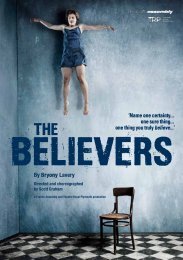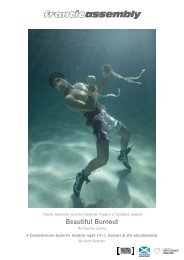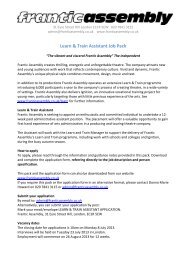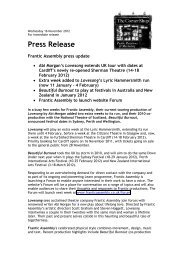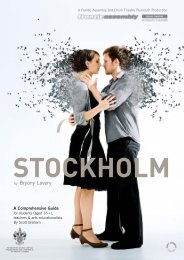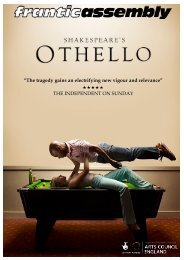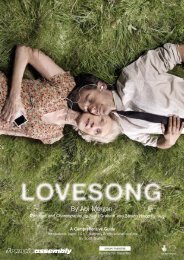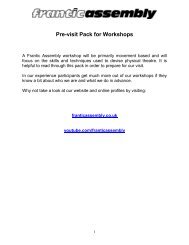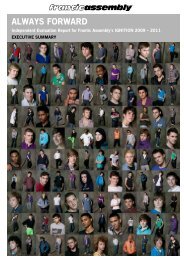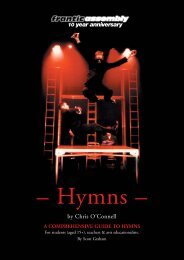Rabbit Resource Pack - Frantic Assembly
Rabbit Resource Pack - Frantic Assembly
Rabbit Resource Pack - Frantic Assembly
Create successful ePaper yourself
Turn your PDF publications into a flip-book with our unique Google optimized e-Paper software.
pattern should mean that when one person is still there are probably a<br />
few people moving and this separates the still person from the chaos.<br />
When the performers are ready they all run their journeys at the same<br />
time. They will all be of slightly different lengths but this is beneficial<br />
because as they loop the material they will always encounter different<br />
people in different places. We ran this sequence several times and it<br />
threw up lots of interesting encounters between the characters. The<br />
more we ran it the more the performers became the characters and the<br />
subtleties and complexities of their stories and relationships came to<br />
the surface. Not only did this open out the hidden complexities of the<br />
text but it created a fascinating physical scene in itself.<br />
We ran the physical routes of the characters under the actual words<br />
and again it betrayed a vivid subtext, an intricate social politic existing<br />
under the skin of the play. This exercise was so successful that elements<br />
of it made it into the show!<br />
Slippery Child<br />
Driver is desperate to get Paul to release him from his duties for the night.<br />
When he finds him in the forest Paul suggests they go to Driver’s sick son.<br />
As they set off Paul becomes delirious and uncontrollable. Driver attempts<br />
to get his mind back on the task and get them both out of the forest.<br />
Physically we asked David Sibley and Karl Sullivan to imagine that Paul has<br />
become a slippery child running off at all angles. Driver struggles to control<br />
this fragile bundle of energy. They set off on this task as we filmed them. We<br />
then looked at the footage and then went back to the material that seemed<br />
to capture the original intention. We set small chunks of material and joined<br />
them together until there was a strong physical routine. It was then that we<br />
went back to the words. Just reading the words alongside the moves threw<br />
up some beautiful accidents, things we would never have thought of if we<br />
had approached the scene by making moves for the words. With the actors<br />
now speaking the words as they move they had created an emotional world<br />
that evoked so much more than the words did on their own.<br />
Driver’s Magic<br />
We have spoken about how we wanted driver to be different from<br />
the others in just about every way. We talked before rehearsals about<br />
how we wanted to create an other world quality about driver. It felt<br />
important to give a character who is not even allowed to divulge his<br />
own name the possession of hidden depths and qualities. He is so<br />
much more than Driver. He is also brilliant at his job but it is his<br />
excellence and utter professionalism that ultimately leads him to<br />
tragedy.<br />
When Driver enters the room he has an impact, a presence. When he<br />
easily deals with Spin and Madeline he sets about putting the room<br />
back in order.<br />
Steven found a piece of music with a complicated time structure and<br />
a syncopated rhythm that would never seem predictable. He then<br />
worked with Karl Sullivan on the construction of a movement<br />
sequence where Driver would sort out the room with intricate<br />
musical precision hitting all sorts of surprising beats and notes.<br />
We wanted this to contrast completely with the way the other<br />
characters relate to the music. None of the others interact with their<br />
soundtracks but Driver is clearly master of his. If the scene works<br />
well the music is the sound of his actions rather than his actions<br />
being movements to the music. He should seem completely in<br />
control. All of this helps create the feeling of a highly capable man<br />
shackled within a restrictive social order.<br />
Physically, difficult things had to seem easy to him. He had to enjoy<br />
what he was doing in the moment. He is alone and free on stage and<br />
this should be a kind of freedom that dissipates upon the entrance of<br />
Paul and Kate.<br />
Kids Let Loose<br />
Driver in the Woods<br />
At the end of the last full week of rehearsals we suddenly<br />
realised that we were missing a possibly vital scene for<br />
Driver. We had created a scene where he receives a<br />
phone call that clearly gives him some terrible news. The<br />
suggestion is that he is too late to see his little boy and<br />
the child has passed away. Following this he is seen in<br />
the woods, numb with the pain of it all, singing the<br />
version of Paul and Madeline’s Frank Sinatra song. We<br />
thought that Driver had to go through some process to<br />
get to this point. Something had to happen between the<br />
phone call and the song.<br />
At this extremely late stage we are talking about a<br />
moment in the woods where Drivers emotions explode. A<br />
physical scene where his anguish boils over and exhausts<br />
him so that we then appreciate the stillness that he<br />
possesses in the song. This is the scene that allows all of<br />
Driver’s pent up rage to come to the surface. So much of<br />
the script has him holding back emotions and bowing to<br />
definition. We were desperate to see what driver would be<br />
capable of outside those confines, outside the world of<br />
Paul Cave and deep in the woods.<br />
We usually don’t particularly like it when a writer tells the director, through a stage direction, to get physical. We feel this often separates the<br />
words from the physicality and creates a predictable pattern to the show.<br />
The flip side of this is when a writer tosses us a gem of a stage direction like ‘Kids let loose’ (p.25). This direction has physical scene written all<br />
over it but the beauty is that while it is not overly prescriptive it says all it needs to say. It has all the attitude of the scene itself.<br />
What is interesting is that its openness means that different productions will create completely different scenes from this simple instruction.<br />
16



